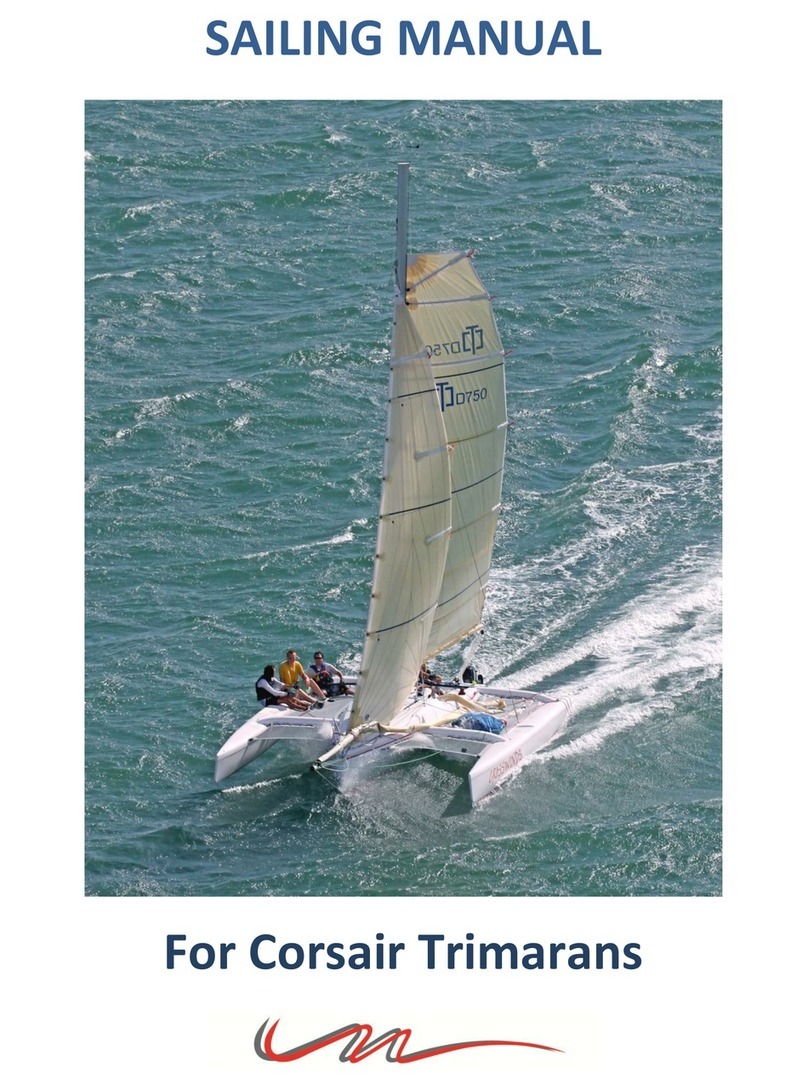
Corsair Foiler 2200 Owner’s Manual -------------------------------------------------------------------------------------------------------------------------------------------------------------------------------------------------------------------------------------------------------------------------------------------------------------------------------------------------------------------------- 5
Seller warrants, for a period of one year from the date of
delivery, to the original (first-use) Purchaser, that any part
of the Corsair Foiler 2200 manufactured by Corsair will be
free of defects in material and workmanship for a period of
twelve (12) months from the date of delivery to the first-
use Purchaser under normal use and service. Seller’s sole
obligation under this warranty shall be limited to replac-
ing, correcting or repairing any part manufactured by
Corsair which is determined by Corsair to be defective by
reason of faulty workmanship or material. This warranty
shall not apply to:
1. Equipment not manufactured by Corsair. Any warranty
made by the manufacturer of such items will be given to
the first-use Purchaser, if possible.
2. Problems or defects caused by accident, misuse, neglect,
improper maintenance, storage, cradling or blocking, neg-
ligent or improper operation, normal wear and tear,
improper repair, corrosion, electrolysis, or improper mod-
ification by persons other than Seller’s employees.
3. Any discoloration, crazing or cracking on all exterior
finishes (including paint, gelcoat and anodizing). Only the
best gelcoats and paints are used but they cannot be war-
ranted as they may be affected by climate or other factors
beyond the control of the Seller.
4. Any damage caused by improper trailering or launching.
5. Defects or faulty workmanship caused by persons other
than the manufacturer, a current authorized Dealer, or a
Corsair-approved repair facility, in modifying or in adding
equipment to the Corsair Foiler 2200 or altering equipment
on the Corsair Foiler 2200, whether or not such equipment
was supplied by the manufacturer.
6. Any costs of transportation, hauling, launching, owner
or crew transport, meals or lodging, storage, dockage, loss
of time, loss of income, or similar costs.
7. Boats used for commercial activities, including charter,
except as allowed under the Limited One Year Warranty
above.
8. Any Boat that has been used in a trans-oceanic passage
exceeding two hundred (200) miles from any coast.
Seler further warrants to the first-use Purchaser, for a peri-
od of ten (10) years that the hulls of the Corsair Foiler
2200 shall be free of any structural defects that may cause
structural failure during normal operation. Seller’s obliga-
tion under this warranty shall be limited to replacing, cor-
recting, or repairing any part which, in the judgment of the
seller, by its failure, has impaired the structural integrity of
the Corsair Foiler 2200.
This structural failure warranty shall be voided if seller
should determine that said components have been subject-
ed to any abuse, including but not limited to collision with
other Boats, structures or objects.
Seller further warrants, for a period of ten (10) years, that
the hull and other fiberglass parts manufactured by Corsair
will be free of gelcoat voids and blisters. Seller’s obliga-
tion under this warranty shall be limited to repairing the
void or blister. The blister limited warranty will be voided:
1. If the gelcoat has been subject to impact or abrasion or
has been sanded or sandblasted.
2. If the recommendations for preserving the gelcoat finish
on marina-docked boats set out in the Corsair Foiler 2200
Owner’s Manual are not followed.
Purchaser shall be responsible for returning the Corsair
Foiler 2200, or any defective part, to Seller’s facility, for
any warranty repairs, with all transportation charges paid
by Purchaser. Seller may, at its option, direct the Purchaser
to transport the Corsair Foiler 2200 to an independent
repair facility for any needed replacements, corrections or
repairs.
Purchaser agrees to promptly notify Corsair of any condi-
tion or part which Purchaser believes to be defective with-
in thirty (30) days of discovering the defect.
PURCHASER AND SELLER AGREE THAT THE
FOREGOING WARRANTY IS EXPRESSLY IN LIEU
OF ANY AND ALL OTHER RERESENTATIONS, WAR-
RANTIES OR CONDITIONS EXPRESSED OR
IMPLIED, INCLUDING ANY IMPLIED WARRANTIES
OR CONDITIONS OF MERCHANTABLITY OR FIT-
NESS FOR A PARTICULAR PURPOSE, AND IS IN
LIEU OF ANY OBLIGATIONS OR LIABILITIES OF
SELLER TO PURCHASER, WHETHER FOR LOSS OF
USE OF THE CORSAIR FOILER 2200, LOSS OF TIME,
INCONVENIENCE, COMMERCIAL LOSS, OR FOR
DIRECT, SPECIAL OR CONSEQUENTIAL DAMAGES
OR OTHERWISE ARISING OUT OF THE USE OF THE
CORSAIR FOILER 2200. THE PURCHASER SPECIFI-
CALLY ACKNOWLEGES AND AGREES THAT THE
FOREGOING SHALL SURVIVE ANY FUNDAMEN-
TAL BREACH OF THIS AGREEMENT. IN SOME
JURISDICTIONS, THE MANUFACTURER IS PROHIB-
ITED FROM EXCLUDING OR LIMITING IMPLIED
WARRANTIES,. IN THOSE JURISDICTIONS THE
MANUFACTURER EXPRESSLY LIMITS ANY
IMPLIED WARRANTIES TO THE GREATEST
EXTENT AND TO THE SHORTEST DURATION
ALLOWED BY LAW.
WARRANTY
AND LIMITATION OF LIABILITY




























